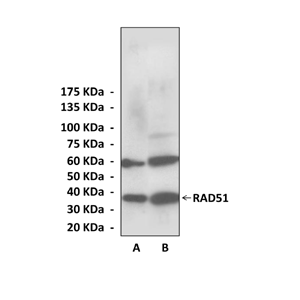Anti-RAD51: Rabbit RAD51 Antibody
Price: $0.00
Description
In vivo, the process of HR is tightly regulated by various mechanisms. Whereas some proteins promote HR, others inhibit this process, thereby preventing its untimely initiation. Disruption of the Rad51-ssDNA nucleoprotein filament appears to be an especially important mechanism of controlling HR. This filament disruption activity was demonstrated for the yeast Srs2 helicase and human RECQ5 helicase. It was also found that BLM, a helicase of the RecQ family, can also catalyze disruption of the RAD51-ssDNA filament. This disruption only occurs if the filament is present in an inactive ADP-bound form, e.g. in the presence of Mg2+. Conversion of RAD51 into an active ATP-bound form, e.g. in the presence of Ca2+ , renders the filament resistant to BLM disruption. However, when BLM interacts with an active ATP-bound RAD51-ssDNA filament, it stimulates the DNA strand exchange activity of RAD51. Thus, depending on the conformational state of the RAD51 nucleoprotein filament, BLM may either inhibit or stimulate the DNA strand exchange activity of RAD51.4 In addition, Human PSF was identified as a component of spliceosomes. It was shown that PSF directly interacted with RAD51. PSF significantly enhanced RAD51-mediated homologous pairing and strand exchange at low RAD51 concentrations; however, in contrast, it inhibited these RAD51-mediated recombination reactions at the optimal RAD51 concentration.
2. Urena, D. E. et al: J. Mol. Biol. 2010 in press
3. Rajendra, E. & Venkitaraman, A.R.: Nucl. Acids Res. 38:82-96, 2010
4. Bugreev, D.V. et al: J. Biol. Chem. 284:26349-59, 2009
Details
| Cat.No.: | CA1219 |
| Antigen: | Short peptide from human RAD51 sequence. |
| Isotype: | Rabbit IgG |
| Species & predicted species cross- reactivity ( ): | Human |
| Applications & Suggested starting dilutions:* | WB 1:1000 IP n/d IHC 1:50 – 1:200 ICC n/d FACS n/d |
| Predicted Molecular Weight of protein: | 37 kDa |
| Specificity/Sensitivity: | Detects endogenous levels of RAD51 proteins without cross-reactivity with other related proteins. |
| Storage: | Store at -20°C, 4°C for frequent use. Avoid repeated freeze-thaw cycles. |
*Optimal working dilutions must be determined by end user.
